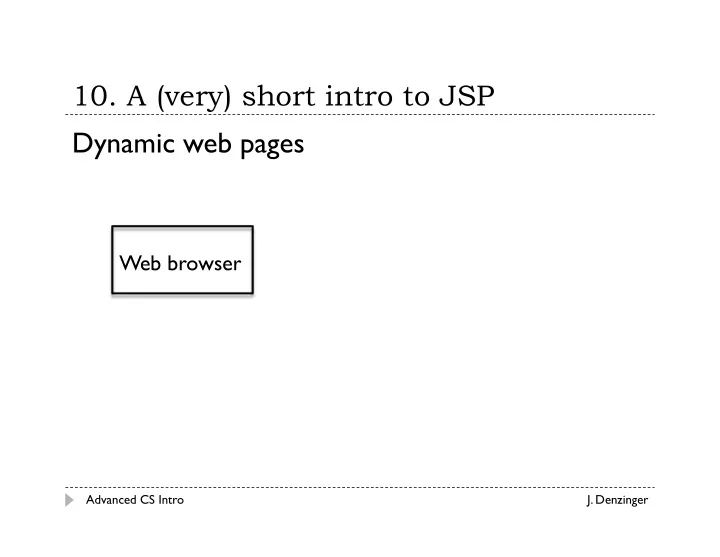

10. A (very) short intro to JSP Dynamic web pages Web browser Advanced CS Intro J. Denzinger
10. A (very) short intro to JSP Dynamic web pages Internet HTTP Request Web browser Advanced CS Intro J. Denzinger
10. A (very) short intro to JSP Dynamic web pages Internet HTTP Request Web browser W Web server Advanced CS Intro J. Denzinger
10. A (very) short intro to JSP Dynamic web pages Internet HTTP Request Web browser Server Ser W Web server Advanced CS Intro J. Denzinger
10. A (very) short intro to JSP Dynamic web pages Internet HTTP Request Web browser JSP JSP Engine Server Ser W Web server Advanced CS Intro J. Denzinger
10. A (very) short intro to JSP Dynamic web pages Internet HTTP Request Web browser JSP JSP Engine Server Ser W Servlet S Engine Web server Advanced CS Intro J. Denzinger
10. A (very) short intro to JSP Dynamic web pages Internet HTTP Request Web browser HTTP Response JSP JSP Engine Internet Server Ser W Servlet S Engine Web server Advanced CS Intro J. Denzinger
10. A (very) short intro to JSP Dynamic web pages Internet HTTP Request Web browser Tomcat HTTP Response JSP JSP Engine Internet Server Ser W Servlet S Engine Web server Advanced CS Intro J. Denzinger
10.1 HTML HyperText Markup Language Method for putting structured information (about formatting of text) into a text file Based on tags Tags enclose information that is displayed according to the semantics of the tag Tags can be nested Tags can have parameters Advanced CS Intro J. Denzinger
10.2 JSP Java Server Pages One way to create dynamic web pages Also tag-based JSP engine allows to combine html tags with Java code (including import statements) to produce a Java servlet Java servlet is then executed to create an html page as result of http request Advanced CS Intro J. Denzinger
JSP elements Scripting: manipulate Java objects by invoking their methods, also can catch exceptions Directive: messages to Tomcat Action: encapsulate activities that Tomcat performs when handling an http request Implicit objects: objects created by Tomcat that can be used in JSPs Advanced CS Intro J. Denzinger
Scripting elements Consists of code delimited by particular character sequences Code is a Java fragment <% … %> for scriplets (block of Java code) <%- … %> for expressions (inserts result of expression into page) <%! … %> for declarations (creates an instance variable shared by all requests for the page) Advanced CS Intro J. Denzinger
Directive elements General syntax: <%@directive-name attr 1 =“value 1 ” [attr 2 =“value 2 ”…] %> page directive defines page-dependent properties and allows setting their values include directive allows to insert unprocessed text file taglib directive allows to include tag libraries Advanced CS Intro J. Denzinger
Action elements General syntax: optional <jsp:action-name attribute-list> <jsp:subaction-name subaction-attribute-list/> </jsp:action-name> Actions are executed every time an http-request is made for the page containing it A user can also define his/her own actions (and associated tags) (which need to be implemented via defining a Java class and require a tag library descriptor realized as an XML file) Advanced CS Intro J. Denzinger
Actions (selection) forward : transfers http-request to another page include : include another page, process it, then continue processing of current page param : subaction that allows to set parameters for pages in forward / include actions element , attribute , body : used to define XML elements Advanced CS Intro J. Denzinger
Implicit objects (selection) Objects (with associated methods) created by Tomcat within one of four scopes: application, session, request or page application provides access to resources shared within the whole web application config is used to pass information to servlets out is used as output request gives access to the HTTP request sent by the browser Advanced CS Intro J. Denzinger
Implicit objects (selection) (cont.) response gives access to the HTTP response that will be sent to the browser session allows to store information about a user session Advanced CS Intro J. Denzinger
10.3 Sources Giulio Zambon: Beginning JSP, JSF and Tomcat Apress, 2012 Advanced CS Intro J. Denzinger
Recommend
More recommend